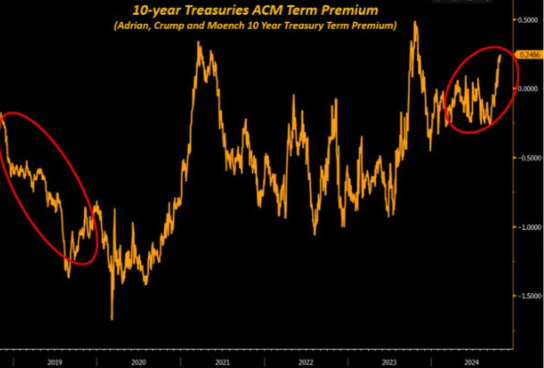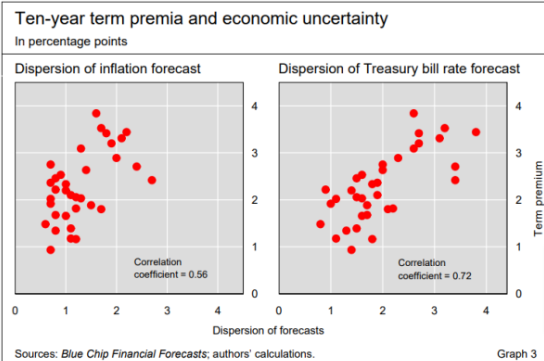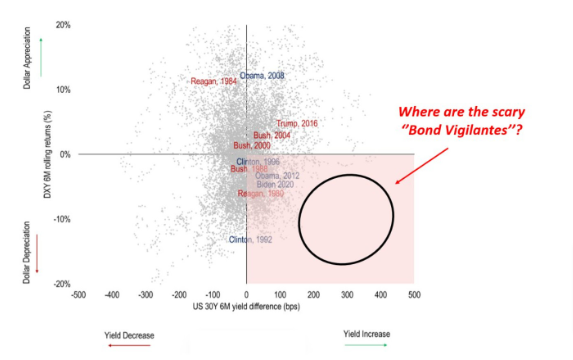The Bond Market is saying “This Time is Different”.
The Term Premium is on the rise, and it now sits close to the highest level for the last 10 years.

But What is Term Premium?
An investor looking to get fixed-income exposure can do that by buying 3-month T-Bills and rolling them each time they mature for the next 10 years.
Alternatively, it can decide to purchase 10-year Treasuries today.
What's the difference?
Interest rate risk.
Buying a 10-year bond today rather than rolling T-Bills for the next 10 years exposes investors to risks – term premium compensates for this risk.
The lower the uncertainty about growth and inflation down the road, the lower the term premium and vice versa.
Uncertainty is the key word here. The higher the uncertainty about future growth and inflation, the higher the term premium.
The left chart below shows how term premium (y-axis) increases with a higher dispersion of forecast (read: uncertainty) for inflation (x-axis):

Today the estimates of the US Term Premium have moved higher and they are now testing the upper side of recent ranges: in other words, there is some more uncertainty being priced in about the path ahead for growth and inflation.
Investors are less confident about a future of predictably contained inflation and growth, and they expect some more volatility and uncertainty down the road.
As we approach US elections, bond markets are telling us - yes, “this time is different”.
Persistent fiscal deficits regardless of who wins US elections can lead to more volatile inflation backdrops, and to more boom/bust cycles.
But as Term Premium is on the rise, should we fear the return of Bond Vigilantes?
Not so fast.
This week, Bond Vigilantes are in action in the UK: the fiscal budget unveiled by the new UK government has been assessed as ‘‘too loose’’, and therefore investors are going after all UK assets - they are selling GBP, selling UK bonds, and even stocks.
Bond Vigilantes are truly in action when they initiate a sell-off in bond markets to impart discipline to policymakers, and they hence generate a spill-over effect to the currency and potentially stock markets too.
But the US is not the UK.
Over the last 40 years, Bond Vigilantes have NEVER been in action in the US:

Over the last 40 years, we never really had investors puking on US assets - true Vigilantes are in action when both bond yields go up, and the USD goes down.
As you can see from the chart, that quadrant is basically empty.
We are instead experiencing people pushing US yields higher and the USD getting stronger. The bond market is hence sending a different message.
''Trump's policies will be stimulative for nominal growth, and the US will grow faster than other countries''.
Additionally, investors are hedging for a scenario in which rates move up fast via options. This is evident in the so-called ''skew'':

This means investors are willing to pay more for bond puts than for bond calls for the next month.
This is unusual: investors normally pay more for ''insurance premium'' (bond calls) than for puts, so this is related to election hedging.
There are no ''Bond Vigilantes'' in action here.
Instead, the bond market is preparing for a Trump victory and for policies that will be stimulative for growth and inflation.
Yet, history shows us this.
Elections are a powerful short-term volatility event. But macroeconomic cycles tend to prevail over time.
Trump was the President in 2019 as well, but as the global macroeconomic cycle was weak 10-year Treasury yields traded as low as 2%.
If Trump secures a sweep, I expect the bond sell-off to accelerate. Your mother and your dog will tell you to sell bonds at 4.50% yields.
That’s when you should consider buying them instead.
Disclaimer: This article was originally published on The Macro (BCBA:BMAm) Compass. Come join this vibrant community of macro investors, asset allocators and hedge funds - check out which subscription tier suits you the most using this link.
